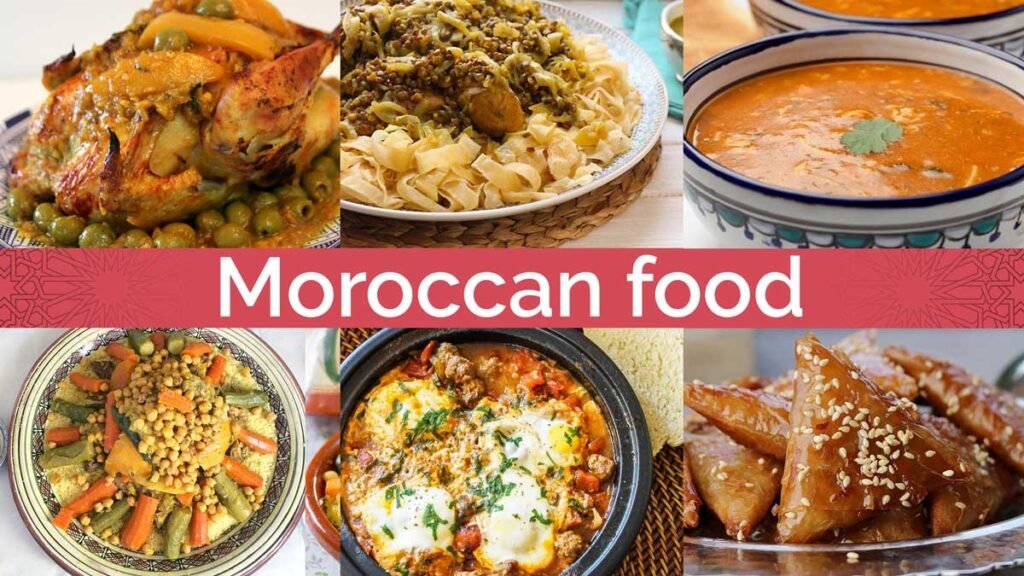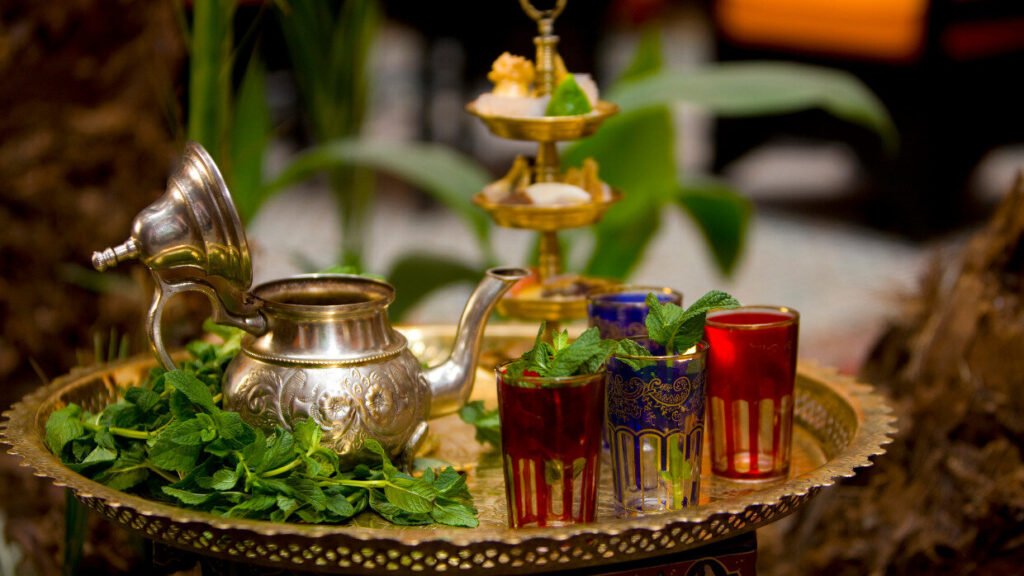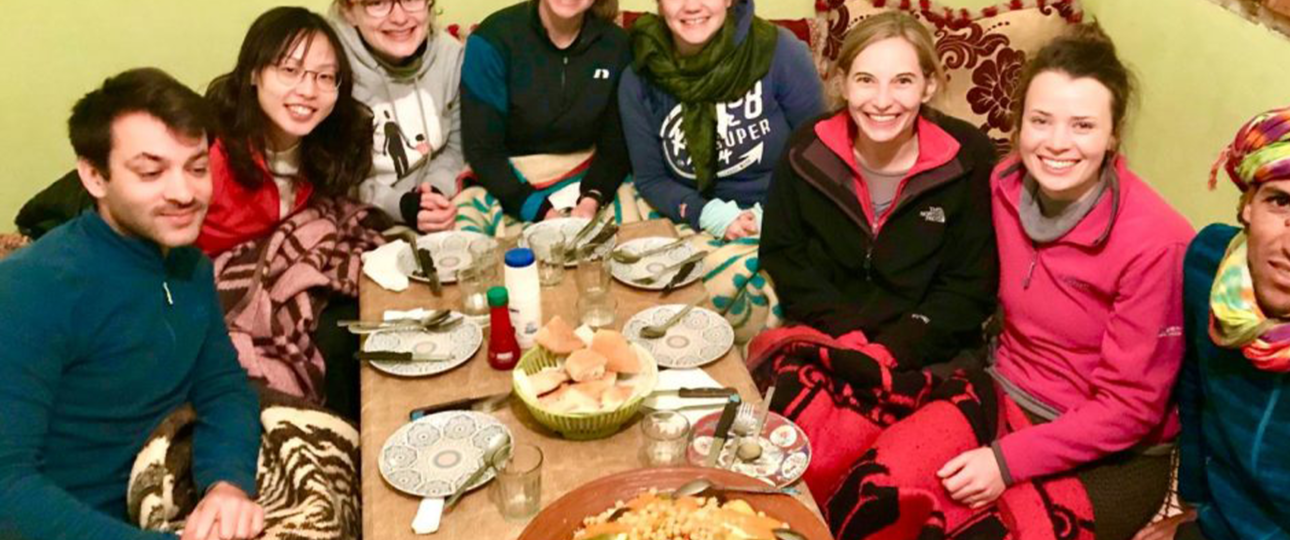Explore Moroccan Cuisine: Diet, Breakfast & Drinks
Explore Moroccan Cuisine: Diet, Breakfast & Drinks
Have you ever wondered what makes Moroccan cuisine so unique and flavorful? Morocco’s rich cultural heritage combines traditional Berber, Arab, Mediterranean, and African cuisines. This blend creates a diverse culinary experience.

The Moroccan diet focuses on fresh ingredients, aromatic spices, and hearty dishes. Traditional breakfast foods and refreshing drinks reflect the country’s history and hospitality.
If you’re interested in trying authentic Moroccan flavors, History Morocco Tours offers guided culinary experiences. To learn more or book a tour, please contact us at +212619958863 or email historymoroccotours@gmail.com.
Key Takeaways
- Moroccan cuisine is a blend of various cultural influences.
- The diet emphasizes fresh ingredients and aromatic spices.
- Traditional breakfast foods are a significant part of Moroccan culinary heritage.
- Refreshing drinks are an integral component of Moroccan meals.
- Guided culinary tours are available through History Morocco Tours.
The Colorful World of Moroccan Culinary Traditions
Moroccan cuisine is a vibrant reflection of the country’s rich cultural heritage. It has been shaped by various influences over the centuries. This has resulted in a unique and flavorful diet that is characteristic of Morocco.
Cultural Significance of Food in Morocco
Food in Morocco is more than sustenance; it’s a part of the country’s identity and culture. Meals are seen as chances to unite families and communities. Traditional dishes are made with love, showing the importance of food in daily life.
The Blend of Berber, Arab, and Mediterranean Influences
The Moroccan diet combines Berber, Arab, and Mediterranean influences. This mix is seen in the use of ingredients and cooking techniques. For example, spices like cumin and coriander show Arab influence. Meanwhile, olive oil and fresh produce reflect Mediterranean cuisine.
| Influence | Characteristics | Examples |
|---|---|---|
| Berber | Use of local ingredients, traditional cooking methods | Tagine, Couscous |
| Arab | Use of spices, sweets | Baklava, Harira |
| Mediterranean | Emphasis on olive oil, fresh produce | Salads, Grilled fish |
For more information or to book a tour, please contact us at +212619958863 or email historymoroccotours@gmail.com. You can also visit our contact page at contact.
The Traditional Moroccan Diet and Its Health Benefits
The Moroccan diet is at the heart of their culinary traditions. It’s both nourishing and flavorful, influenced by Mediterranean eating patterns. The diet focuses on whole foods, fresh produce, and spices that add depth to dishes.
Staple Ingredients in the Moroccan Diet
The Moroccan diet includes olive oil, fresh vegetables, fruits, and whole grains. These are the basics of a healthy eating pattern, similar to Mediterranean cuisine. Legumes, like lentils and chickpeas, are also key. They offer protein and fiber.
The Mediterranean-Inspired Eating Pattern
The Moroccan diet is inspired by the Mediterranean eating pattern. This pattern is known for its health benefits. It emphasizes fruits, vegetables, whole grains, and healthy fats, like olive oil.
| Food Group | Examples | Health Benefits |
|---|---|---|
| Fruits and Vegetables | Oranges, Tomatoes, Carrots | Rich in Vitamins and Antioxidants |
| Whole Grains | Barley, Couscous, Whole Wheat Bread | High in Fiber, Supports Digestive Health |
| Healthy Fats | Olive Oil, Nuts, Seeds | Supports Heart Health, Rich in Antioxidants |
Spices and Herbs: The Flavor Foundation
Spices and herbs are essential in Moroccan cuisine. They add flavor and aroma without salt or sugar. Common spices include cumin, coriander, ginger, and cinnamon. Fresh herbs like parsley, cilantro, and mint add freshness to dishes, including Moroccan breakfast food like Msemen and Beghrir.
For more information on Moroccan cuisine and culture, or to book a tour, please contact us at +212619958863 or email historymoroccotours@gmail.com. You can also visit our contact page at contact.
Moroccan Breakfast Food: Morning Rituals and Favorites
In Morocco, breakfast is more than a meal. It’s a cultural experience that brings people together. It sets the tone for the day.
It’s a time for families to gather and share stories. They enjoy traditional dishes passed down through generations.
Msemen and Other Traditional Breads
Msemen is a staple of Moroccan breakfast. It’s a square-shaped flatbread with fillings like onions, meat, or spices. Other traditional breads include Khobz and M’Hamas.
These breads are often enjoyed with Moroccan mint tea. This refreshing tea is a big part of Moroccan culture.

Beghrir: Moroccan Pancakes
Beghrir, or Moroccan pancakes, are a favorite. They’re small, round pancakes made with flour, yeast, and water. They’re cooked on a griddle.
They’re served with honey, butter, or jam. They make for a delightful start to the day.
Savory Breakfast Options
Moroccan breakfasts also have savory dishes. Bissara, a hearty bean soup, is one. Other bean-based dishes are also popular.
These meals are often served with bread or olives. They provide a satisfying start to the day.
Bissara and Bean-Based Dishes
Bissara is made from dried fava beans, garlic, and olive oil. It’s a nutritious and flavorful breakfast option. It’s rich in protein and fiber.
Other bean-based dishes, like ful medames, a fava bean stew, are also popular. They’re great for breakfast.
For more information on Moroccan cuisine, or to book a tour, contact us at +212619958863 or email historymoroccotours@gmail.com. Visit our contact page at contact.
Popular Moroccan Drinks for Every Occasion
Morocco’s culture shines through its drinks, from teas to juices. These beverages are key to the country’s welcoming spirit. They’re enjoyed at social events and special times.

Moroccan Mint Tea: The Ceremony and Significance
Moroccan Mint Tea is more than a drink; it’s a sign of friendship and hospitality. Making this tea is a special ritual. It involves picking fresh mint and green tea carefully.
The tea is poured into fancy teapots and small glasses. These are often decorated with beautiful designs. Moroccan Mint Tea brings people together, creating a sense of community.
The tea’s unique taste comes from fresh mint. It’s sweetened with a lot of sugar. This balances the tea’s bitterness and the mint’s freshness.
Coffee Variations and Customs
Coffee is big in Morocco, with its own traditions. Moroccan coffee is flavored with spices like cardamom or cinnamon. It tastes unique.
Coffee is served in small cups. It’s a big part of social gatherings. It’s often enjoyed with sweet treats.
Fresh Fruit Juices and Smoothies
Fruit juices and smoothies are refreshing in Morocco. Juices from oranges and pomegranates are favorites. They’re served cold and sweet.
Smoothies with yogurt, fruits, and nuts are common in cafes. They’re a cool and healthy drink option.
Unique Beverages: Almond Milk and Avocado Shakes
Morocco has unique drinks like almond milk and avocado shakes. Almond milk is flavored with orange blossom water. It tastes exotic.
Avocado shakes are creamy and indulgent. They show how versatile Moroccan drinks can be.
For more on Moroccan culture and food, or to plan a tour, call +212619958863 or email historymoroccotours@gmail.com. Visit our contact page at contact.
Moroccan Main Dishes and Dining Customs
In Morocco, main dishes are more than just food. They are a big part of the country’s culture and how people connect. The traditional diet is full of flavors, thanks to Morocco’s Berber, Arab, and Mediterranean roots.
Tagine: The Iconic Clay Pot Cooking
The Tagine is a key dish in Morocco. It’s cooked in a clay pot with a special lid. This method makes the meat, vegetables, and fruits tender and full of flavor.
Couscous: The Friday Tradition
Couscous is a big deal in Morocco, especially on Fridays. It’s a special pasta made from semolina flour. It’s served with veggies, meat, and sauce, bringing families together.
Eating with Hands and Other Dining Etiquette
Dining in Morocco is all about sharing. People often eat with their hands, using the right hand only. It’s important to respect your hosts and guests, showing gratitude for the meal.
| Dish | Description | Occasion |
|---|---|---|
| Tagine | Slow-cooked stew made with meat, vegetables, and dried fruits | Special occasions and family gatherings |
| Couscous | Traditional North African pasta served with vegetables, meat, and sauce | Fridays and special celebrations |
| Msemen | Square-shaped pancake made with layers of dough, often served with honey or savory fillings | Breakfast or snack |
Want to dive into Moroccan cuisine and culture? Or plan a tour with delicious food stops? Call us at +212619958863 or email historymoroccotours@gmail.com. Visit our contact page for more info.
Culinary Experiences on Your Moroccan Tour
Morocco’s food scene is a colorful mix of tastes and smells. It’s a place where different cultures meet, making it perfect for food lovers. You’ll find everything from Berber to Arab and Mediterranean flavors.
Food Markets and Souks Worth Visiting
Exploring local food markets and souks is a must on any Moroccan food tour. These lively places are full of fresh food, spices, and treats. You can try foods like olives, dates, and pastries as you wander through the stalls.
Cooking Classes and Food Workshops
Joining a cooking class or food workshop is a great way to dive into Moroccan cuisine. You’ll learn how to make dishes like tagines and couscous. It’s a hands-on way to discover the secrets of Moroccan cooking.
Regional Specialties Across Morocco
Morocco’s food varies greatly from one region to another. The coast offers seafood dishes, while the Atlas Mountains are known for their stews. Trying these local flavors is a big part of any Moroccan food tour.
For more information or to book a tour, please contact us at +212619958863 or email historymoroccotours@gmail.com. You can also visit our contact page at contact.
Conclusion: Embracing the Flavors of Morocco
Moroccan cuisine is a vibrant reflection of the country’s rich cultural heritage. It shows the diverse influences and traditions. Every meal, from Moroccan breakfast food to Moroccan drinks, is a chance to feel Morocco’s warmth and hospitality.
We’ve looked into the colorful world of Moroccan culinary traditions. We’ve talked about the traditional Moroccan diet and the role of food in Moroccan culture. We’ve also explored popular Moroccan breakfast food like Msemen and Beghrir, and the variety of Moroccan drinks enjoyed daily.
If you want to dive into Morocco’s flavors, History Morocco Tours has a unique culinary experience. To book a tour or learn more, contact us at +212619958863 or email historymoroccotours@gmail.com. Visit our contact page at contact.
FAQ
What are the staple ingredients in the traditional Moroccan diet?
The traditional Moroccan diet focuses on olive oil, fresh veggies, fruits, whole grains, and lean proteins. These are mixed with spices and herbs.
What is the significance of Moroccan Mint Tea in Moroccan culture?
Moroccan Mint Tea is a sign of hospitality. It’s a key part of Moroccan culture, served to guests as a sign of respect and welcome.
What are some popular Moroccan breakfast foods?
Popular breakfast foods include Msemen, a traditional bread, and Beghrir, a pancake. There are also savory dishes like Bissara, a bean-based dish.
What are some unique Moroccan drinks?
Unique drinks include almond milk and avocado shakes. They are refreshing and full of flavor.
What is the traditional Moroccan method of cooking Tagine?
Tagine is cooked in a clay pot with a conical lid. This method allows for slow cooking, keeping flavors and aromas in.
How do Moroccans typically dine?
Moroccans often eat with their hands, using bread to pick up food. Dining etiquette values respect for food, company, and tradition.
What culinary experiences can I expect on a Moroccan tour?
On a Moroccan tour, you’ll visit food markets and souks. You’ll also join cooking classes and food workshops. Plus, you’ll try regional specialties across Morocco.
What are the health benefits of the traditional Moroccan diet?
The traditional Moroccan diet is rich in whole grains, fruits, veggies, and lean proteins. It’s linked to lower risks of chronic diseases.

